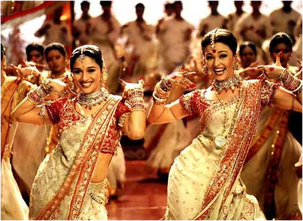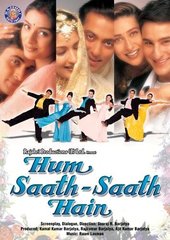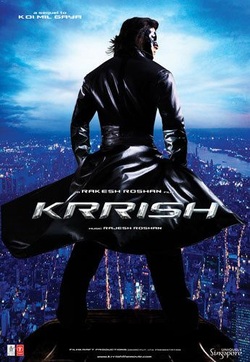| A Brief Introduction to Hinduism |
Hinduism and Bollywood
Many Bollywood movies directly and indirectly reference Hindu deities, such as the 2006 film Krrish, which follows a character who has the superhuman powers of the deity Krishna. This referencing hails back to Bollywood’s long history of telling and retelling the stories from Hindu texts.
Unlike Hindu theater, though, Bollywood’s origins do not have a spiritual explanation. The Indian film industry began in 1899 when photographer Harischandra Sakharam Bhatavdekar filmed a wrestling match and released it under the title The Wrestlers. A few years earlier, in 1896, British occupants had introduced the Indian sub-continent to cinema, and now India was beginning to take tentative strides toward adapting this western technology. Bollywood truly began to take form in 1913, when Dadasaheb Phalke released Raja Harishchandra during the silent film era. This film, based on mythological characters, was only the start of a focus on India and Hinduism's past that Bollywood continues today. But it was in the '30s that modern Bollywood began: now was the era of "talkies." Inspired by early Disney animated musicals and their own traditions, Indian film-makers crafted live-action music dramas. Music remains essential to Bollywood still today, and became the boon that rocketed Bollywood to new heights.
Since then, the story of Indian cinema has been a story of growth, and by the ‘90s, Bollywood offered films in as many genres as any other modern nation. Now, Bollywood is a film industry beginning to rival Hollywood, earning large investments from Indian firms (Zee, UTV, Adlabs) and western firms (20th Century Fox, Warner Bros) alike. In 2009, Bollywood out-performed Hollywood by selling 3.2 billion movie tickets. This is no religious art-house film studio; it is big business through-and-through.
Just as Indian theater did in the past, Bollywood's recent film production has drawn from Hinduism's diverse cast of colorful gods and the lives of Hindu saints, though at times it incorporates Islamic and even Christian thought as well. But even though Bollywood does reveal foreign influence, it still has a special affinity for Hinduism. As UCLA historian Vinay Lal says, "It is the Ramayana, Mâha-bharâtâ, and Puranas that would provide the principal fodder for the 'mythological.' The film Subhadra…dramatized the disagreement between Krishna and his stepbrother Balarama over the marriage of their sister Subhadra. Shri Krishnavataram…recounted major episodes from Krishna's life. The list [of Hindu Epic-inspired films], one might say, is endless."
Like Hollywood, Bollywood has its share of interesting gossip as well, though with a religious tint. Known for playing Krishna in as many as seventeen films, actor N. T. Rama Rao had fans who lauded him so much that, as Lal tells us, like a strange, eastern Reagan-cum-Schwarzenegger, he managed to achieve great success as a politician. Lal continues jokingly: "he played the role of gods so often that his fans mistook him for one." And even in this technological age, Hinduism for India is not a strange, exotic faith—it is as innocuous as Christianity is in the west. As John Keay poetically observes, "televised serializations of the Sanskrit Epics can bring the entire Indian nation to a hushed standstill." Although Hinduism does not form the basis of all Bollywood productions or Indian cinema, it still leaves its marks in the celluloid.
Unlike Hindu theater, though, Bollywood’s origins do not have a spiritual explanation. The Indian film industry began in 1899 when photographer Harischandra Sakharam Bhatavdekar filmed a wrestling match and released it under the title The Wrestlers. A few years earlier, in 1896, British occupants had introduced the Indian sub-continent to cinema, and now India was beginning to take tentative strides toward adapting this western technology. Bollywood truly began to take form in 1913, when Dadasaheb Phalke released Raja Harishchandra during the silent film era. This film, based on mythological characters, was only the start of a focus on India and Hinduism's past that Bollywood continues today. But it was in the '30s that modern Bollywood began: now was the era of "talkies." Inspired by early Disney animated musicals and their own traditions, Indian film-makers crafted live-action music dramas. Music remains essential to Bollywood still today, and became the boon that rocketed Bollywood to new heights.
Since then, the story of Indian cinema has been a story of growth, and by the ‘90s, Bollywood offered films in as many genres as any other modern nation. Now, Bollywood is a film industry beginning to rival Hollywood, earning large investments from Indian firms (Zee, UTV, Adlabs) and western firms (20th Century Fox, Warner Bros) alike. In 2009, Bollywood out-performed Hollywood by selling 3.2 billion movie tickets. This is no religious art-house film studio; it is big business through-and-through.
Just as Indian theater did in the past, Bollywood's recent film production has drawn from Hinduism's diverse cast of colorful gods and the lives of Hindu saints, though at times it incorporates Islamic and even Christian thought as well. But even though Bollywood does reveal foreign influence, it still has a special affinity for Hinduism. As UCLA historian Vinay Lal says, "It is the Ramayana, Mâha-bharâtâ, and Puranas that would provide the principal fodder for the 'mythological.' The film Subhadra…dramatized the disagreement between Krishna and his stepbrother Balarama over the marriage of their sister Subhadra. Shri Krishnavataram…recounted major episodes from Krishna's life. The list [of Hindu Epic-inspired films], one might say, is endless."
Like Hollywood, Bollywood has its share of interesting gossip as well, though with a religious tint. Known for playing Krishna in as many as seventeen films, actor N. T. Rama Rao had fans who lauded him so much that, as Lal tells us, like a strange, eastern Reagan-cum-Schwarzenegger, he managed to achieve great success as a politician. Lal continues jokingly: "he played the role of gods so often that his fans mistook him for one." And even in this technological age, Hinduism for India is not a strange, exotic faith—it is as innocuous as Christianity is in the west. As John Keay poetically observes, "televised serializations of the Sanskrit Epics can bring the entire Indian nation to a hushed standstill." Although Hinduism does not form the basis of all Bollywood productions or Indian cinema, it still leaves its marks in the celluloid.
Hindu Traditions in Bollywood

In the Bollywood film industry, all Hindu directors intentionally wait for a predetermined auspicious day called the Muhurat when they release their films or music videos. This day is determined by specific numerologies that typically celebrate the director’s chosen deity.
Most directors and actors will also go to Hindu temples and pray for days on end for the success of their movies before the release.
Most directors and celebrities have their own personal gurus who help them through their careers by integrating yoga, worship, and dharma into their daily routines.
Although Hinduism is becoming slightly less prominent in the plot of most Bollywood movies, most directors will include a popular chant, hymn, or song celebrating a deity. In these chants or songs, the choreographed dances are typically based on the yoga poses of Hindu deities.
Below is a typical Bollywood dance scene, from the film Bride & Prejudice. The song is called "Balle Balle."
Most directors and actors will also go to Hindu temples and pray for days on end for the success of their movies before the release.
Most directors and celebrities have their own personal gurus who help them through their careers by integrating yoga, worship, and dharma into their daily routines.
Although Hinduism is becoming slightly less prominent in the plot of most Bollywood movies, most directors will include a popular chant, hymn, or song celebrating a deity. In these chants or songs, the choreographed dances are typically based on the yoga poses of Hindu deities.
Below is a typical Bollywood dance scene, from the film Bride & Prejudice. The song is called "Balle Balle."
Hum Saath-Saath Hain

By director Sooraj Barjatya, Hum Saath-Saath Hain, is a romantic comedy detailing the happenings of a household during a wedding anniversary. As visitors arrive, passions ignite between guests and family members. But unlike western movies, the household finds time to frequently break into song as the plot takes its course. One jaunty dance number, "Maiya Yashoda," has the family’s daughters detail the feelings of falling in love through allusions to Krishna. They sing, "Mother [of Krishna], your [son] / he flirts with me…Whenever [Krishna] plays the flute / my anklets tinkle / when he flirts with me with his eyes / I cannot help but hold my heart." Visual symbolism plays a role as well. As the daughters dance, a man passes behind them serving drinks. He looks up excitedly toward a small shrine to Krishna and Radha to his left, and leaves the remaining drinks on the tray in front of it. Later, one of the bystanders passes the daughter singing a flute, which she coyly holds to the side of her mouth like Krishna. Below is a video of the song.
"Maiya Yashoda," as a celebration of Vaishnavism, draws on a wealth of associations between music, dance, and religion that exist in Indian culture. Though still thoroughly modern, the practices of ancient Sanskrit theater survive in this six-minute scene.
Krrish

Krrish is a dramatic sci-fi action flick that takes inspiration from both western and eastern sources in equal measure. As the movie opens, Krishna is an orphan boy who shows extraordinary gifts, which first become apparent when he outperforms his classmates in math. Sonia, his grandmother, realizes that the true nature of the boy’s power is much more, and sends him off to hide so he won’t put his life in danger. Krishna grows up in the woods, and as critic Ronnie Scheib puts it, "There, the plump little geek develops into a gorgeous hunk who communes with animals and smiles contentedly at all creation." One day, a woman named Priya falls for him--literally; she lands among the trees in a parachute. Krishna falls in love, and the two begin to tease and flirt through sequences marked by duets.
But Priya’s intentions do not remain pure for long; as an employee of a Singapore-based media company, she is threatened with losing her job for spending too long on vacation. To remedy this, she takes Krishna with her back home, where she intends to show off her new super-boyfriend to earn the favor of her boss. But before leaving, Krishna promises Sonia that he will not reveal his true abilities. However, Krishna has no choice but to act when, after "a three-ring Bombay circus showstopper, [he] appears on cue to save children trapped in a burning tent—performing a death-defying rescue that may be the only thing that could top the just-wrapped song," as critic Ronnie Scheib puts it.
But Priya’s intentions do not remain pure for long; as an employee of a Singapore-based media company, she is threatened with losing her job for spending too long on vacation. To remedy this, she takes Krishna with her back home, where she intends to show off her new super-boyfriend to earn the favor of her boss. But before leaving, Krishna promises Sonia that he will not reveal his true abilities. However, Krishna has no choice but to act when, after "a three-ring Bombay circus showstopper, [he] appears on cue to save children trapped in a burning tent—performing a death-defying rescue that may be the only thing that could top the just-wrapped song," as critic Ronnie Scheib puts it.
Wearing a black clown mask and an inside-out jacket as a disguise, Krishna has become Krrish. After learning his presumed-dead father is in fact still alive, Krishna as Krrish begins to take on a mad scientist and other "baddies" in a rescue mission. The movie culminates with this rescue and Krrish’s destruction of the mad scientist’s doomsday device. He, his father, and Priya return to India to reunite with Krishna’s mother. Roll credits.
Despite its western influences, Krrish still reveals its culture; beyond the hero’s obvious link with the god Krishna, most of the movie’s running time focuses not on action, but romance, song, and dance. The focus on romance calls back to Hindu theology: Ravi Swami notes, "Pretty much every Indian god had a de-rigueur 'consort'—a yin to balance the yang, again, something reflected in both Krrish and Robot." And even in the action sequences, the style draws more from The Matrix and less from Rambo; moves are choreographed to emphasize grace and smoothness, not raw strength. In one scene, for example, Krrish takes on a biker gang by effortlessly flipping through the air and spinning motorcycles like tops between black-leather-clad ne’er-do-wells, as if playing a giant game of Pachinko.
Despite its western influences, Krrish still reveals its culture; beyond the hero’s obvious link with the god Krishna, most of the movie’s running time focuses not on action, but romance, song, and dance. The focus on romance calls back to Hindu theology: Ravi Swami notes, "Pretty much every Indian god had a de-rigueur 'consort'—a yin to balance the yang, again, something reflected in both Krrish and Robot." And even in the action sequences, the style draws more from The Matrix and less from Rambo; moves are choreographed to emphasize grace and smoothness, not raw strength. In one scene, for example, Krrish takes on a biker gang by effortlessly flipping through the air and spinning motorcycles like tops between black-leather-clad ne’er-do-wells, as if playing a giant game of Pachinko.
The focus on the trappings of Hindu tradition, musical romance, and superhero action reflect the current dual nature of Indian society: its ties with the deep past, and its westernization launched by British colonization.
Drawing from the models of the Bhârata Sûtras and western superheroes both, as Ravi Swami observes, Krrish represents a modern India’s response to the superhero genre. As Swami humorously points out, Hindu gods may elicit a plea of nolo contendere from western staples such as Superman and Batman when forcing them to compete: "You can imagine a conversation in the ancient world as ideas and mythologies were traded across continents: 'So Hercules killed the Nemean Lion?—well, Hanuman lifted a whole mountain…there, top that!'" As a good-natured call-back to ancient societal customs, Krrish both preserves and modernizes Hindu theater and theology, at the same time revealing Bollywood’s essential paradox of eastern ideas shown through modern western films. Despite being one of the oldest religions, Hinduism is not mired in the past; it lives vibrantly through new (if sometimes unconventional) venues.
Sources:
http://202.138.122.66/news/analysing-numerology-bollywoods-favourite-fad/345378/
“History of Bollywood.” Bollywood Tourism. Bollywood Tourism, 2009. Web. 4 Dec. 2011.
Jain, Pankaj. “Bollywood and Beyond: Hinduism Changing the World.” patheos. patheos, 28 June 2010. Web. 4 Dec. 2011.
“Krrish Movie Poster.” Krrish. Advertisement. IMP Awards. Internet Movie Poster Awards, 2 Oct. 2006. Web. 4 Dec. 2011.
Kumar, Alok. “Hum Saath Saath Hain.” Planet-Bollywood. Planet-Bollywood, 1999. Web. 4 Dec. 2011.
Lal, Vinay. "Hinduism and Bollywood: A Few Notes." MANAS. Ed. Vinay Lal. U of California Los Angeles, 4 July 2006. Web. 12 Dec. 2011.
Roshan, Rakesh, dir. Krrish. 2006. Filmkraft Productions. YouTube. Web. 4 Dec. 2011.
Scheib, Ronnie. “Krrish.” Variety Reviews. Variety, 7 July 2006. Web. 4 Dec. 2011.
Swami, Ravi. “The State of the Indian Superhero.” Non-Resident Indian. N.p., 7 Aug. 2006. Web. 4 Dec. 2011.
---. “The Return of the Super-Sadhu?” Non-Resident Indian. N.p., 5 Sept. 2011. Web. 4 Dec. 2011.
Yagnik, Alka, Anuradha Paudwal, and Kavita Krishnamurthy, perf. Hum Saath Saath Hain. Ram Laxman. Dir. Sooraj Barjatya. 1999. Rajshri Productions. YouTube. Web. 4 Dec. 2011.
Drawing from the models of the Bhârata Sûtras and western superheroes both, as Ravi Swami observes, Krrish represents a modern India’s response to the superhero genre. As Swami humorously points out, Hindu gods may elicit a plea of nolo contendere from western staples such as Superman and Batman when forcing them to compete: "You can imagine a conversation in the ancient world as ideas and mythologies were traded across continents: 'So Hercules killed the Nemean Lion?—well, Hanuman lifted a whole mountain…there, top that!'" As a good-natured call-back to ancient societal customs, Krrish both preserves and modernizes Hindu theater and theology, at the same time revealing Bollywood’s essential paradox of eastern ideas shown through modern western films. Despite being one of the oldest religions, Hinduism is not mired in the past; it lives vibrantly through new (if sometimes unconventional) venues.
Sources:
http://202.138.122.66/news/analysing-numerology-bollywoods-favourite-fad/345378/
“History of Bollywood.” Bollywood Tourism. Bollywood Tourism, 2009. Web. 4 Dec. 2011.
Jain, Pankaj. “Bollywood and Beyond: Hinduism Changing the World.” patheos. patheos, 28 June 2010. Web. 4 Dec. 2011.
“Krrish Movie Poster.” Krrish. Advertisement. IMP Awards. Internet Movie Poster Awards, 2 Oct. 2006. Web. 4 Dec. 2011.
Kumar, Alok. “Hum Saath Saath Hain.” Planet-Bollywood. Planet-Bollywood, 1999. Web. 4 Dec. 2011.
Lal, Vinay. "Hinduism and Bollywood: A Few Notes." MANAS. Ed. Vinay Lal. U of California Los Angeles, 4 July 2006. Web. 12 Dec. 2011.
Roshan, Rakesh, dir. Krrish. 2006. Filmkraft Productions. YouTube. Web. 4 Dec. 2011.
Scheib, Ronnie. “Krrish.” Variety Reviews. Variety, 7 July 2006. Web. 4 Dec. 2011.
Swami, Ravi. “The State of the Indian Superhero.” Non-Resident Indian. N.p., 7 Aug. 2006. Web. 4 Dec. 2011.
---. “The Return of the Super-Sadhu?” Non-Resident Indian. N.p., 5 Sept. 2011. Web. 4 Dec. 2011.
Yagnik, Alka, Anuradha Paudwal, and Kavita Krishnamurthy, perf. Hum Saath Saath Hain. Ram Laxman. Dir. Sooraj Barjatya. 1999. Rajshri Productions. YouTube. Web. 4 Dec. 2011.
